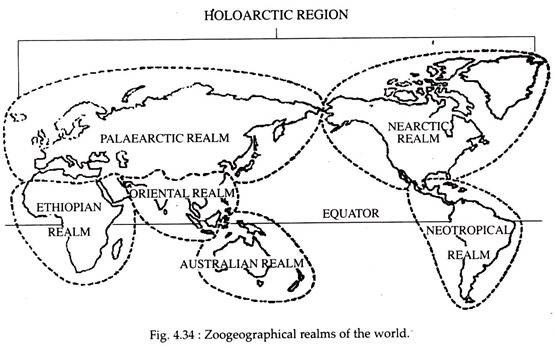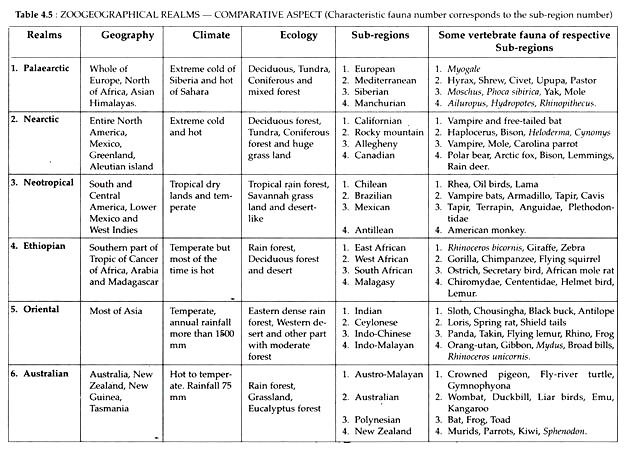In this article we will discuss about the Zoogeographical Realms:- 1. Meaning of Zoogeographical Realms 2. Types of Zoogeographical Realms.
Meaning of Zoogeographical Realms:
On the basis of presence and absence of several organisms, the earth can be divided into some regions. These regions are called realms. Several scientists proposed several scheme of realms. P. L. Sclater (1857) divided the geographical areas of the Earth into six parts, on the basis of the distribution of birds.
After that, Alfred Russel Wallace in 1876 published a paper on zoogeographical realms. He retained the ‘six area concept’ of Sclater, but included in his study all the terrestrial vertebrates and invertebrates. The only change, he made was in renaming the Indian region of Sclater to Oriental region.
The realms, which they described were all separated by distinctive barriers from each other. The scheme of division proposed by Wallace is presented here and the realms are separated by dotted lines on world map, which are known as Wallace’s line (Fig. 4.34).
Types of Zoogeographical Realms:
a. Palaearctic Realm.
b. Nearctic Realm.
c. Neo-tropical Realm.
d. Ethiopian Realm.
ADVERTISEMENTS:
e. Oriental Realm.
f. Australian Realm.
The details of the above realms are given below:
a. Palaearctic Realm:
A. Geographical Boundary:
ADVERTISEMENTS:
Geographically this realm consists of whole of Europe, Northern part of Africa and Asian Himalaya and Nan ling range of China.
B. Sub-divisions:
This realm is further divided into four sub-divisions by Wallace.
(i) European Sub-region:
Northern and Central Europe, Black Kokesus.
(ii) Mediterranean Sub-region:
Part of Africa, Asia, Europe, Arab, Afghanistan and Baluchistan.
(iii) Siberian Sub-region:
Northern part of Himalaya, i.e., Northern Asia.
ADVERTISEMENTS:
(iv) Manchurian Sub-region:
Mongolia, Korea, Manchuria, Japan.
C. Climatic Condition:
Extreme cold of Siberia and extreme hot of Sahara desert are characteristic climate of this region.
D. Ecological Condition:
Deciduous forest, large grass land, coniferous forest and mixed forest. Tundra area is also present in this region.
E. Characteristic Vertebrate Fauna:
(i) Fish:
Carp, Salmon, Pike, Sticklebacks are common in freshwater of this region
(ii) Amphibia:
European Salamander, Proteius, Hynobius, Bombinator, Alytes, Didocus etc.
(iii) Reptiles:
Sand boa, lizard – Trigonophis and Alligator.
(iv) Birds:
Arctic tern, pheasant, wrens, finches, warblers, geese etc.
(v) Mammals:
Among 39 families of characteristic mammals, family – Seluinidae and Ailuropodie are endemic. Other mammals are porcupine, dog, wild ass, European bison, polar cat, deer, etc.
b. Nearctic Realm:
A. Geographical Boundary:
This region consists, on its north the entire of North America, in south up to Mexico, in East Greenland and in west Aleutian islands.
B. Sub-divisions:
It is also sub-divided into four sub-regions.
(i) Californian Sub-region:
Vancouver Island part of British Colombia, Nevada and some part of Cascade hill region, are the areas of this region. It is commonly known as the low biodiversity area.
(ii) Rocky Mountain Sub-region:
Eastern side of California has a high and rocky mountain range. This region contains a rich zoo-diversity among Nearctic region.
(iii) Allegheny Sub-region:
This sub- region is situated at the eastern side of the rocky mountain sub-region. It’s northern part is bounded by Great lakes. This sub-region is with moderate zoo property.
(iv) Canadian Sub-region:
This sub- region consists of North America and Greenland and is not renowned for its animal contents.
C. Climatic Condition:
Like Palaearctic region this region also has extreme cold and hot climate.
D. Ecological Condition:
Deciduous forest range, huge grass land, coniferous forest, dry land and Tundra regions are prominent ecological zonations.
E. Characteristic Vertebrate Fauna:
(i) Fishes:
Lepisosteus, Polydon, Acipenser and varieties of perches.
(ii) Amphibia:
Siren, Amphiuma, Cryptobranchus, Ambystoma, Ascaphys and Axolotl larva. Most of them belong to caudata.
(iii) Reptiles:
Conophis, Chilomeniscus, Pituophis, Farancia are prominent snakes. Phrynosoma, Uta are lizards and Aromochelys and Chelydra are turtles.
(iv) Birds:
Turkey, pelican, crow, cuckoo, pigeon, saras, swan, kite, rel, owl, hawk, etc. Most of them are migratory birds.
(v) Mammals:
Didelphis, Armadillo, Caribou, pronghorn, srew, mole, bear, wolf, monkey, deer, bat, goat, mask ox, bison, etc. The mammalian family Aplodontidae and Pronghorn are endemic.
c. Neo-tropical Realm:
A. Geographical Boundary:
South and central America lower Mexico and West Indies are the constituents of this region. This region is connected with Nearctic region by central American isthmus and other parts are bordered by the sea.
B. Sub-divisions:
This is also sub-divided into four sub-regions:
(i) Chilean Sub-region:
Western part of South America, Peru, Bolivia and Andes mountain range are the different parts of this region. It is not so rich in faunal content.
(ii) Brazilian Sub-region:
It covers whole of Brazil and extends up to the Panama canal. It is very rich in faunal composition.
(iii) Mexican Sub-region:
This sub-region is situated within North and South America, i.e., northern side of the Panama isthmus. It contains some important fauna.
(iv) Antillean Sub-region:
Entire West Indies except Trinidad and Tobago is included in this sub-region. Very few animal content is the characteristics of this sub-region.
C. Climatic Condition:
Most parts of this region is covered by tropical dry lands. Only southern part of America experiences temperate climate.
D. Ecological Condition:
In the Amazon valley there is tropical rain forest. Temperate region consists of Savannah and grassland. Western part of South America is dry and has desert like ecosystem. Argentina comprises mostly of grassland.
E. Characteristic Vertebrate Fauna:
(i) Fishes:
120 genus of the three families (Polycentridae, Gymnotidae and Trigonidae) are present in this region. The prominent fishes are Lepidosiren, eel, catfish, etc.
(ii) Amphibia:
Caecilia, Siphonopsis, Hyla, Salamander, frog, toad, etc.
(iii) Reptiles:
Dromicus, Boa, Epicrates, snakes, Gecko, Alligator, Chelys, etc.
(iv) Birds:
Total 700 genus of birds are recorded in this region. Among these rea, tenemus, screamus, whatgin, to wean, thrush, parakeet.
(v) Mammals:
Total 32 families are recorded of which opossum, caenolestes, sloth, armadillo, rodents, American tapir, bat, spider monkey, lama, etc. are important.
d. Ethiopian Realm:
A. Geographical Boundary:
It consists of southern part of the Tropic of cancer, most of the African mainland, southern part of Arabia and Madagascar.
B. Sub-divisions:
It is also sub-divided into four sub-regions.
(i) East African Sub-region:
Hot and dry region of Africa and Arabia are included in this sub-region.
(ii) West African Sub-region:
Western part of the Ethiopian region is extended up to Kongo in this sub-region.
(iii) South African Sub-region:
Whole of the southern part of Africa is included in this sub-region.
(iv) Malagasy:
Whole of Madagascar is included in this sub-region.
C. Climatic Condition:
Mainly temperate in most of the areas, but remains hot during most time of the year.
D. Ecological Condition:
The areas on the equinoctial line and West Africa possess rain forest along the sides of large rivers. Most of the other parts are dry deciduous forest. Northern and Southern parts of the region are transformed into desert.
E. Characteristic Vertebrate Fauna:
(i) Fishes Cat fishes, lung fishes (Protopterus, Polypterus) and several fresh water fishes are present.
(ii) Amphibia:
Xenopus and several species of caecilians are present. The group caudata is completely absent.
(iii) Reptiles:
Among snakes, Leptorhynchus, Ramnophis, etc.; among lizards, Monotrophis, Cordylus, Agama, Chameleon, etc. are prominent species.
(iv) Birds:
67 families of Aves are recorded. Some important species, are ostrich, cuckoo, parakeet, eagle, kite, pigeon, hornbill, etc.
(v) Mammals:
The recorded families are 51 of which 15 are endemic. The remarkable species are zebra, gorilla, antilope, leopard, two horned rhinoceros, hippopotamus, lemur, gnu, beboon, lion, giraffe, chimpanzee, loxodonta, etc.
e. Oriental Realm:
A. Geographical Boundary:
Most of the Asian countries which are situated at the southern side of Himalaya are included in this realm. India, Burma, Indo-China, Malay, Sumatra, Java, Bali, Borneo and Filipines, etc. are within this realm.
B. Sub-divisions:
It is composed of four sub-regions.
(i) Indian Sub-region:
From the base of Himalaya the whole of the Indian subcontinent is under this sub-region. Division of Indian sub-region – Indian sub-region was separated on the basis of distribution of molluscs, reptiles, birds and mammals by Wallace (1876). In 1942, Mahendra further divided Indian sub-region into divisions on the basis of floral and faunal contents.
The divisions are as follows:
1. Dry and semidry area of Northern India
2. Western side of Himalaya
3. Southern part of Burma
4. Plateau of Ganges
5. Southern India below 20° latitude
6. Ganga plateau and area above 20° latitude
7. Tribankur
8. Ceylon
9. Nicobar islands
10. Andaman islands
(ii) Ceylonese Sub-region:
Part of the Indian peninsula and Sri Lanka are covered under this sub-region.
(iii) Indo-Chinese Sub-region:
South China, Burma, Thailand and Indochina fall within the border of this sub-region.
(iv) Indo-Malayan Sub-region:
This is eastern part of the oriental realm. Malay and East-Indies islands are included in this sub-region.
C. Climatic Condition:
Most part experience temperate atmosphere. Annual rainfall more than 1500 mm.
D. Ecological Condition:
Eastern part contains dense rain forest. Western part possess a desert. Other parts are having moderate forest.
E. Characteristic vertebrate fauna:
(i) Fishes:
Different types of carp, catfish, notopteridae, osteoglocid, cipriniformes, etc.
(ii) Amphibians:
Varieties of anurans, some salamanders and caecilians are present.
(iii) Reptiles:
Various types of snakes like, viper, pit viper, kraits, etc.; lizards- like, Gekko, Aagamid, Varanus, Chamellion, Crocodiles, Gavialis. Platysternidae family of turtles are present.
(iv) Birds:
Pigeons, owls, finches, phesants, peacock, saras, etc., are present.
(v) Mammals:
Srew, rabbit, dog, cat, boar, rodents, flying lemur, elephants, ox, tiger, orangutan, gibbon, tapir, pangolin, Rhinoceros unicorns, etc., are important members. Out of 30 families only 4 are endemic.
f. Australian Realm:
A. Geographical Boundary:
Australia, New Zealand, New Guinea, Tasmania and some islands of adjacent areas are included in this realm.
B. Sub-divisions:
This is divided into four sub-regions.
(i) Austro-Malayan Sub-regions:
Malay archipelago including New Guinea, Moluccas and Solomon island are covering this sub-region.
(ii) Australian Sub-region:
Tasmania and Australia are the parts of this sub- region.
(iii) Polynesian Sub-region:
Polynesia and Sand-wick islands are included in this sub-region.
(iv) New Zealand Sub-region:
New Zealand, Norfolk island, Auckland, Campbell and Macquarie islands comprises this sub-region.
C. Climatic Condition:
Hot and temperate, both types of climate are present here. Average rainfall in a year is 75 mm.
D. Ecological Condition:
Rain forest, grassland, eucalyptus forest are prominent ecological characters.
E. Characteristic Vertebiate Fauna:
(i) Fishes:
Neoceratodus Lung fish, Osteoglocidos, Gadopcidae, etc.
(ii) Amphibia:
Xenorhinidae family is present in New Guinea only.
Pseudophryne, Pachybatrachus, Helioporus, Pelodyrus are other important members. Total 11 families are recorded.
(iii) Reptiles:
Important snake families are Phithonidae and Elapidae: Pizopidae, Apracidae, Liadidae are prominent lizards. Sphenodon of Rhynchocephalidae family is the famous relict of reptiles present in New Zealand.
(iv) Birds:
Casuary, liar bird, magpie, emu, kiwi, scrab, bawar are important members of this region. Nine hundred and six species of birds are recorded from this region.
(v) Mammals:
Ornithorhynchus (a marsupial), Tachyglossus (ant eater), Kangaroo, Dasyures, Dendrolagus (climbing kangaroo), Petaurus (flying opossum), wolf are the remarkable members.

